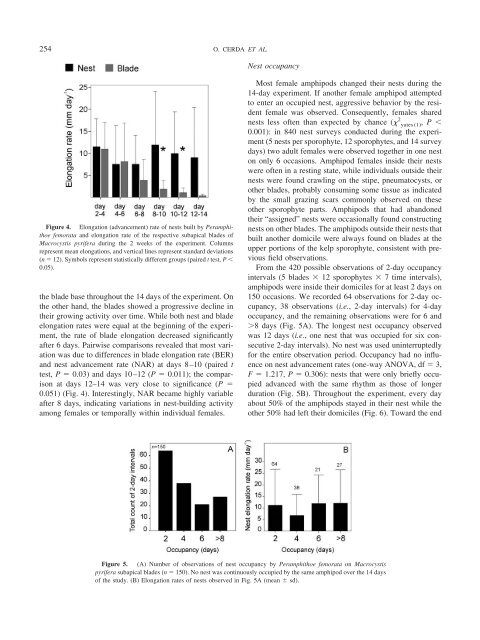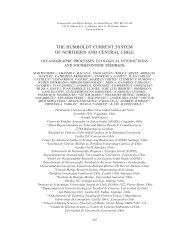Nest-Building Behavior by the Amphipod Peramphithoe ... - Bedim
Nest-Building Behavior by the Amphipod Peramphithoe ... - Bedim
Nest-Building Behavior by the Amphipod Peramphithoe ... - Bedim
Create successful ePaper yourself
Turn your PDF publications into a flip-book with our unique Google optimized e-Paper software.
254 O. CERDA ET AL.<br />
<strong>Nest</strong> occupancy<br />
Figure 4. Elongation (advancement) rate of nests built <strong>by</strong> <strong>Peramphithoe</strong><br />
femorata and elongation rate of <strong>the</strong> respective subapical blades of<br />
Macrocystis pyrifera during <strong>the</strong> 2 weeks of <strong>the</strong> experiment. Columns<br />
represent mean elongations, and vertical lines represent standard deviations<br />
(n 12). Symbols represent statistically different groups (paired t test, P <br />
0.05).<br />
<strong>the</strong> blade base throughout <strong>the</strong> 14 days of <strong>the</strong> experiment. On<br />
<strong>the</strong> o<strong>the</strong>r hand, <strong>the</strong> blades showed a progressive decline in<br />
<strong>the</strong>ir growing activity over time. While both nest and blade<br />
elongation rates were equal at <strong>the</strong> beginning of <strong>the</strong> experiment,<br />
<strong>the</strong> rate of blade elongation decreased significantly<br />
after 6 days. Pairwise comparisons revealed that most variation<br />
was due to differences in blade elongation rate (BER)<br />
and nest advancement rate (NAR) at days 8–10 (paired t<br />
test, P 0.03) and days 10–12 (P 0.011); <strong>the</strong> comparison<br />
at days 12–14 was very close to significance (P <br />
0.051) (Fig. 4). Interestingly, NAR became highly variable<br />
after 8 days, indicating variations in nest-building activity<br />
among females or temporally within individual females.<br />
Most female amphipods changed <strong>the</strong>ir nests during <strong>the</strong><br />
14-day experiment. If ano<strong>the</strong>r female amphipod attempted<br />
to enter an occupied nest, aggressive behavior <strong>by</strong> <strong>the</strong> resident<br />
female was observed. Consequently, females shared<br />
nests less often than expected <strong>by</strong> chance ( 2 yates (1), P <br />
0.001): in 840 nest surveys conducted during <strong>the</strong> experiment<br />
(5 nests per sporophyte, 12 sporophytes, and 14 survey<br />
days) two adult females were observed toge<strong>the</strong>r in one nest<br />
on only 6 occasions. <strong>Amphipod</strong> females inside <strong>the</strong>ir nests<br />
were often in a resting state, while individuals outside <strong>the</strong>ir<br />
nests were found crawling on <strong>the</strong> stipe, pneumatocysts, or<br />
o<strong>the</strong>r blades, probably consuming some tissue as indicated<br />
<strong>by</strong> <strong>the</strong> small grazing scars commonly observed on <strong>the</strong>se<br />
o<strong>the</strong>r sporophyte parts. <strong>Amphipod</strong>s that had abandoned<br />
<strong>the</strong>ir “assigned” nests were occasionally found constructing<br />
nests on o<strong>the</strong>r blades. The amphipods outside <strong>the</strong>ir nests that<br />
built ano<strong>the</strong>r domicile were always found on blades at <strong>the</strong><br />
upper portions of <strong>the</strong> kelp sporophyte, consistent with previous<br />
field observations.<br />
From <strong>the</strong> 420 possible observations of 2-day occupancy<br />
intervals (5 blades 12 sporophytes 7 time intervals),<br />
amphipods were inside <strong>the</strong>ir domiciles for at least 2 days on<br />
150 occasions. We recorded 64 observations for 2-day occupancy,<br />
38 observations (i.e., 2-day intervals) for 4-day<br />
occupancy, and <strong>the</strong> remaining observations were for 6 and<br />
8 days (Fig. 5A). The longest nest occupancy observed<br />
was 12 days (i.e., one nest that was occupied for six consecutive<br />
2-day intervals). No nest was used uninterruptedly<br />
for <strong>the</strong> entire observation period. Occupancy had no influence<br />
on nest advancement rates (one-way ANOVA, df 3,<br />
F 1.217, P 0.306): nests that were only briefly occupied<br />
advanced with <strong>the</strong> same rhythm as those of longer<br />
duration (Fig. 5B). Throughout <strong>the</strong> experiment, every day<br />
about 50% of <strong>the</strong> amphipods stayed in <strong>the</strong>ir nest while <strong>the</strong><br />
o<strong>the</strong>r 50% had left <strong>the</strong>ir domiciles (Fig. 6). Toward <strong>the</strong> end<br />
Figure 5. (A) Number of observations of nest occupancy <strong>by</strong> <strong>Peramphithoe</strong> femorata on Macrocystis<br />
pyrifera subapical blades (n 150). No nest was continuously occupied <strong>by</strong> <strong>the</strong> same amphipod over <strong>the</strong> 14 days<br />
of <strong>the</strong> study. (B) Elongation rates of nests observed in Fig. 5A (mean sd).










